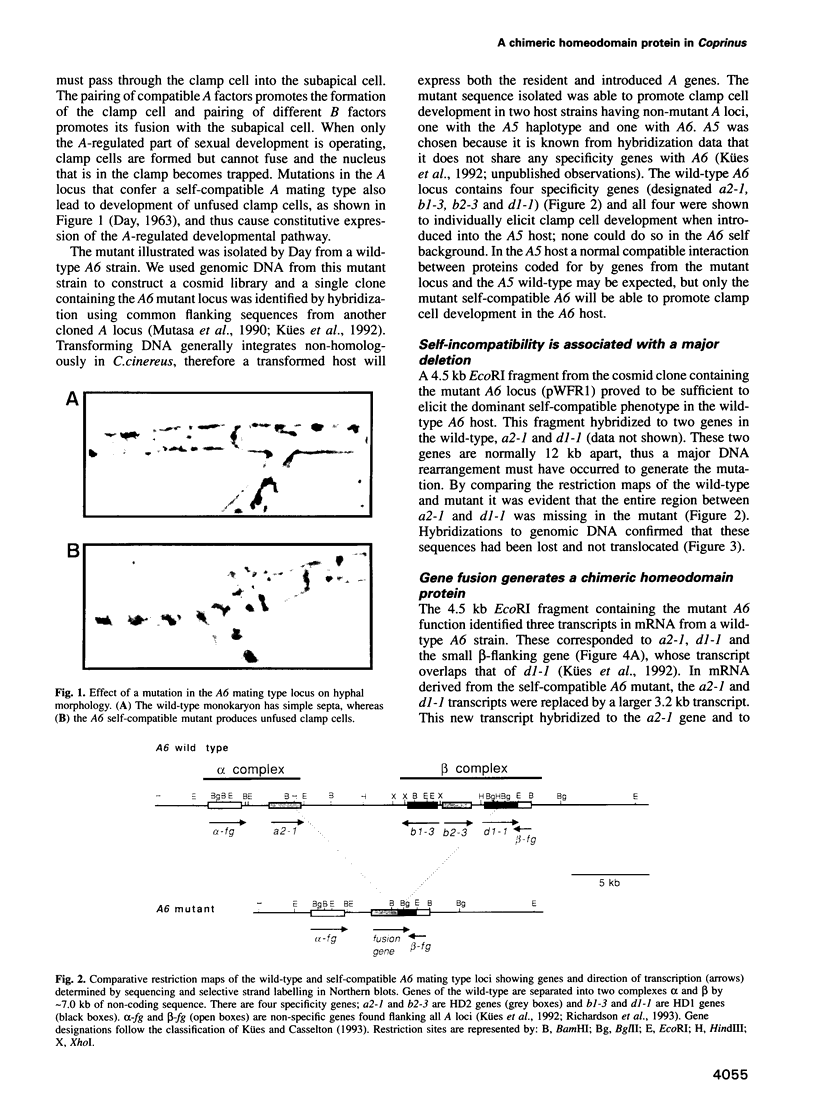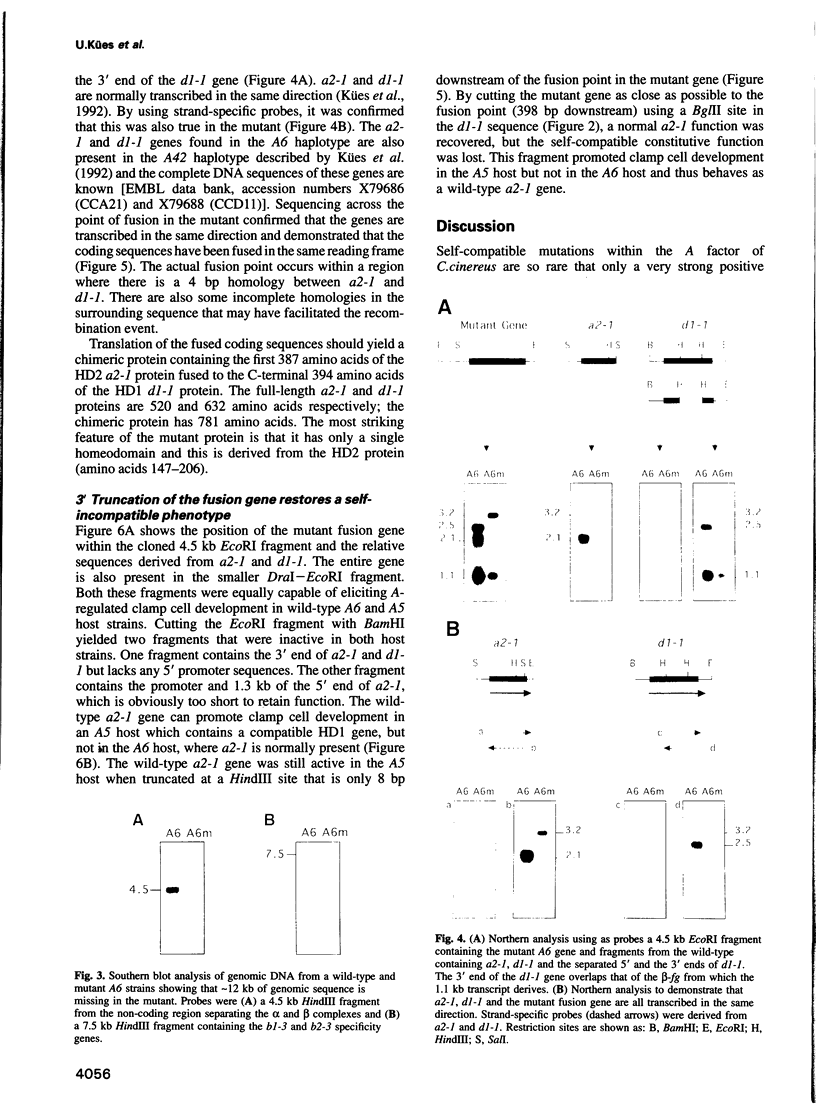Abstract
The A mating type genes of the mushroom Coprinus cinereus encode two classes of putative transcription factor with distinctive homeodomain motifs (HD1 and HD2). A successful mating brings together different allelic forms of these genes and this triggers part of a developmental sequence required for sexual reproduction. In this report we provide evidence that this developmental programme is promoted by a physical interaction between the two classes of homeodomain protein. Rare dominant mutations conferring self-compatibility map to the A locus and result in constitutive operation of the A-regulated developmental pathway. Our molecular analysis of one of these mutations shows that it has generated a chimeric gene by inframe fusion of an HD2 and an HD1 gene. Fusion has overcome the normal incompatibility between two proteins coded by genes of the same A locus and generated a protein that is sufficient to promote development in the absence of any other active A mating type genes. The fusion protein retains most of the HD2 sequence, but only the C-terminal part of the HD1 protein. It has only the HD2 homeodomain motif as a potential DNA binding domain fused to an essential C-terminal region of the HD1 protein, which in a normal HD1-HD2 protein complex may be the major activation domain.
Full text
PDF





Images in this article
Selected References
These references are in PubMed. This may not be the complete list of references from this article.
- Ananthan J., Baler R., Morrissey D., Zuo J., Lan Y., Weir M., Voellmy R. Synergistic activation of transcription is mediated by the N-terminal domain of Drosophila fushi tarazu homeoprotein and can occur without DNA binding by the protein. Mol Cell Biol. 1993 Mar;13(3):1599–1609. doi: 10.1128/mcb.13.3.1599. [DOI] [PMC free article] [PubMed] [Google Scholar]
- Bakkeren G., Kronstad J. W. Conservation of the b mating-type gene complex among bipolar and tetrapolar smut fungi. Plant Cell. 1993 Jan;5(1):123–136. doi: 10.1105/tpc.5.1.123. [DOI] [PMC free article] [PubMed] [Google Scholar]
- Binninger D. M., Skrzynia C., Pukkila P. J., Casselton L. A. DNA-mediated transformation of the basidiomycete Coprinus cinereus. EMBO J. 1987 Apr;6(4):835–840. doi: 10.1002/j.1460-2075.1987.tb04828.x. [DOI] [PMC free article] [PubMed] [Google Scholar]
- Cleary M. L. Oncogenic conversion of transcription factors by chromosomal translocations. Cell. 1991 Aug 23;66(4):619–622. doi: 10.1016/0092-8674(91)90105-8. [DOI] [PubMed] [Google Scholar]
- Day P R. The Structure of the a Mating Type Locus in Coprinus Lagopus. Genetics. 1960 May;45(5):641–650. doi: 10.1093/genetics/45.5.641. [DOI] [PMC free article] [PubMed] [Google Scholar]
- Dedera D. A., Waller E. K., LeBrun D. P., Sen-Majumdar A., Stevens M. E., Barsh G. S., Cleary M. L. Chimeric homeobox gene E2A-PBX1 induces proliferation, apoptosis, and malignant lymphomas in transgenic mice. Cell. 1993 Sep 10;74(5):833–843. doi: 10.1016/0092-8674(93)90463-z. [DOI] [PubMed] [Google Scholar]
- Dolan J. W., Fields S. Cell-type-specific transcription in yeast. Biochim Biophys Acta. 1991 Feb 16;1088(2):155–169. doi: 10.1016/0167-4781(91)90051-m. [DOI] [PubMed] [Google Scholar]
- Dranginis A. M. Binding of yeast a1 and alpha 2 as a heterodimer to the operator DNA of a haploid-specific gene. Nature. 1990 Oct 18;347(6294):682–685. doi: 10.1038/347682a0. [DOI] [PubMed] [Google Scholar]
- Fitzpatrick V. D., Percival-Smith A., Ingles C. J., Krause H. M. Homeodomain-independent activity of the fushi tarazu polypeptide in Drosophila embryos. Nature. 1992 Apr 16;356(6370):610–612. doi: 10.1038/356610a0. [DOI] [PubMed] [Google Scholar]
- Gillissen B., Bergemann J., Sandmann C., Schroeer B., Bölker M., Kahmann R. A two-component regulatory system for self/non-self recognition in Ustilago maydis. Cell. 1992 Feb 21;68(4):647–657. doi: 10.1016/0092-8674(92)90141-x. [DOI] [PubMed] [Google Scholar]
- Goutte C., Johnson A. D. Recognition of a DNA operator by a dimer composed of two different homeodomain proteins. EMBO J. 1994 Mar 15;13(6):1434–1442. doi: 10.1002/j.1460-2075.1994.tb06397.x. [DOI] [PMC free article] [PubMed] [Google Scholar]
- Kamps M. P., Look A. T., Baltimore D. The human t(1;19) translocation in pre-B ALL produces multiple nuclear E2A-Pbx1 fusion proteins with differing transforming potentials. Genes Dev. 1991 Mar;5(3):358–368. doi: 10.1101/gad.5.3.358. [DOI] [PubMed] [Google Scholar]
- Kamps M. P., Murre C., Sun X. H., Baltimore D. A new homeobox gene contributes the DNA binding domain of the t(1;19) translocation protein in pre-B ALL. Cell. 1990 Feb 23;60(4):547–555. doi: 10.1016/0092-8674(90)90658-2. [DOI] [PubMed] [Google Scholar]
- Kües U., Richardson W. V., Tymon A. M., Mutasa E. S., Göttgens B., Gaubatz S., Gregoriades A., Casselton L. A. The combination of dissimilar alleles of the A alpha and A beta gene complexes, whose proteins contain homeo domain motifs, determines sexual development in the mushroom Coprinus cinereus. Genes Dev. 1992 Apr;6(4):568–577. doi: 10.1101/gad.6.4.568. [DOI] [PubMed] [Google Scholar]
- Mak A., Johnson A. D. The carboxy-terminal tail of the homeo domain protein alpha 2 is required for function with a second homeo domain protein. Genes Dev. 1993 Oct;7(10):1862–1870. doi: 10.1101/gad.7.10.1862. [DOI] [PubMed] [Google Scholar]
- May G., Le Chevanton L., Pukkila P. J. Molecular analysis of the Coprinus cinereus mating type A factor demonstrates an unexpectedly complex structure. Genetics. 1991 Jul;128(3):529–538. doi: 10.1093/genetics/128.3.529. [DOI] [PMC free article] [PubMed] [Google Scholar]
- Nourse J., Mellentin J. D., Galili N., Wilkinson J., Stanbridge E., Smith S. D., Cleary M. L. Chromosomal translocation t(1;19) results in synthesis of a homeobox fusion mRNA that codes for a potential chimeric transcription factor. Cell. 1990 Feb 23;60(4):535–545. doi: 10.1016/0092-8674(90)90657-z. [DOI] [PubMed] [Google Scholar]
- Nucifora G., Begy C. R., Erickson P., Drabkin H. A., Rowley J. D. The 3;21 translocation in myelodysplasia results in a fusion transcript between the AML1 gene and the gene for EAP, a highly conserved protein associated with the Epstein-Barr virus small RNA EBER 1. Proc Natl Acad Sci U S A. 1993 Aug 15;90(16):7784–7788. doi: 10.1073/pnas.90.16.7784. [DOI] [PMC free article] [PubMed] [Google Scholar]
- PARAG Y. Mutations in the B incompatibility factor of Schizophyllum commune. Proc Natl Acad Sci U S A. 1962 May 15;48:743–750. doi: 10.1073/pnas.48.5.743. [DOI] [PMC free article] [PubMed] [Google Scholar]
- Pukkila P. J., Yashar B. M., Binninger D. M. Analysis of meiotic development in Coprinus cinereus. Symp Soc Exp Biol. 1984;38:177–194. [PubMed] [Google Scholar]
- Rao P. S., Niederpruem D. J. Carbohydrate metabolism during morphogenesis of Coprinus lagopus (sensu Buller). J Bacteriol. 1969 Dec;100(3):1222–1228. doi: 10.1128/jb.100.3.1222-1228.1969. [DOI] [PMC free article] [PubMed] [Google Scholar]
- Raper J. R., Boyd D. H., Raper C. A. Primary and secondary mutations at the incompatibility loci in Schizophyllum. Proc Natl Acad Sci U S A. 1965 Jun;53(6):1324–1332. doi: 10.1073/pnas.53.6.1324. [DOI] [PMC free article] [PubMed] [Google Scholar]
- Richardson W. V., Kües U., Casselton L. A. The A mating-type genes of the mushroom Coprinus cinereus are not differentially transcribed in monokaryons and dikaryons. Mol Gen Genet. 1993 Apr;238(1-2):304–307. doi: 10.1007/BF00279559. [DOI] [PubMed] [Google Scholar]
- Sealy-Lewis H. M., Casselton L. A. Restoration of enzyme activity by recessive missense suppressors in the fungus Coprinus. Mol Gen Genet. 1978 Aug 17;164(2):211–215. doi: 10.1007/BF00267386. [DOI] [PubMed] [Google Scholar]
- Specht C. A., Stankis M. M., Giasson L., Novotny C. P., Ullrich R. C. Functional analysis of the homeodomain-related proteins of the A alpha locus of Schizophyllum commune. Proc Natl Acad Sci U S A. 1992 Aug 1;89(15):7174–7178. doi: 10.1073/pnas.89.15.7174. [DOI] [PMC free article] [PubMed] [Google Scholar]
- Tornow J., Zeng X., Gao W., Santangelo G. M. GCR1, a transcriptional activator in Saccharomyces cerevisiae, complexes with RAP1 and can function without its DNA binding domain. EMBO J. 1993 Jun;12(6):2431–2437. doi: 10.1002/j.1460-2075.1993.tb05897.x. [DOI] [PMC free article] [PubMed] [Google Scholar]
- Tymon A. M., Kües U., Richardson W. V., Casselton L. A. A fungal mating type protein that regulates sexual and asexual development contains a POU-related domain. EMBO J. 1992 May;11(5):1805–1813. doi: 10.1002/j.1460-2075.1992.tb05232.x. [DOI] [PMC free article] [PubMed] [Google Scholar]
- Yee A. R., Kronstad J. W. Construction of chimeric alleles with altered specificity at the b incompatibility locus of Ustilago maydis. Proc Natl Acad Sci U S A. 1993 Jan 15;90(2):664–668. doi: 10.1073/pnas.90.2.664. [DOI] [PMC free article] [PubMed] [Google Scholar]
- von Lindern M., Fornerod M., van Baal S., Jaegle M., de Wit T., Buijs A., Grosveld G. The translocation (6;9), associated with a specific subtype of acute myeloid leukemia, results in the fusion of two genes, dek and can, and the expression of a chimeric, leukemia-specific dek-can mRNA. Mol Cell Biol. 1992 Apr;12(4):1687–1697. doi: 10.1128/mcb.12.4.1687. [DOI] [PMC free article] [PubMed] [Google Scholar]







